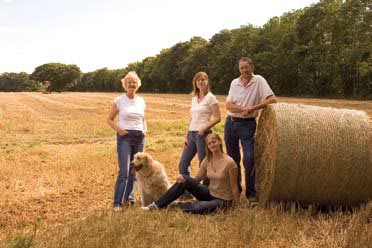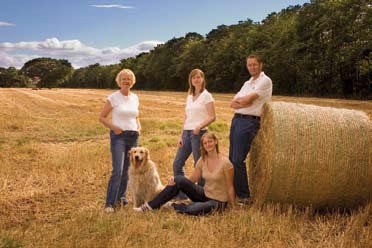articles/Lighting/fillflash-page1
Fill Flash - part 1 of 1
by Terry Hansen Published 01/06/2006

I can hear the groans already. Terry Hansen banging on again about fill flash. Yes, I am and with every good reason. I am seeing far too much poor control of lighting both in the studio and on location. Here is a typical example and if you will permit my indulgence, I illustrate the topic with my own family portrait.
For years I have wanted a portrait with my wife Sue and my two daughters. This became more pressing when last summer my older daughter was emigrating to Florida to become a therapist at a boot camp in the middle of a swamp (it takes all sorts). I said to Sue that this summer is possibly the last time we will all be together until either the girls get married or either you or I die and we have a funeral and at that point one of us will not look our best. My younger daughter is a teacher on the south coast - as far away from me as she can get without emigrating. You would think that after all these years my children of 30 years and 25 years would co-operate in having a family portrait created, but no. I threatened, I cajoled, I begged. They sulked, locked themselves in their bedrooms and threatened to call Child Line. (Can you call Child Line when you are 30?) However, in the end they relented.
Anyway back to the family portrait. I wanted a large portrait with warm tones to match the decor in our lounge; even Max the golden retriever is colour coordinated. My first thought was going to some local sand dunes, but when walking Max close to home I came across a recently harvested field with stubble and bales of hay. Just the colours and tones I required.
A quick decision. Both girls were home at the same time, it was a fine day, a location that was just right. All we needed was someone to take the pictures. A phone-call to a nonphotographic friend to come walkies with us and take a set of pictures.
Off we went, found our location and the angle we wanted.
I was not too keen on the lighting, but not wanting to overburden our non-photographic friend we pressed on, she took some pictures as we posed. (It's not easy holding your stomach in for several minutes at a time.) I checked the back of my Nikon D70 camera. The framing was not good, legs chopped off, etc. I zoomed the camera out a bit and asked our friend to make sure our feet were included as well as our heads.
Looking at the back of the camera, my thoughts about the lighting were confirmed. To get the angle we wanted, showing the sky, field and hay bale, meant the lighting was too much behind and to one side and the shadows were way too deep. Nothing else for it, we must use fill flash.

There was no way that a reflector could provide enough light over such a distance. I set the flash up, hung a power pack on our friend's shoulder and crossed my fingers that it would not all get dropped in the mud. The results where superb.
When I downloaded onto my computer, the difference between the flashed and not flashed pictures were like chalk and cheese. We selected a flashed one, cropped it to about two-thirds of the file and upsized it in RAW, as I described in an earlier article, and made a print two feet by three. The quality is amazing and especially from a Nikon D70 that is, as the phrase goes, as cheap as chips.
Look at the two pictures. Wouldn't you have the one with the flash? The other one is just a nonstarter. The control of lighting is as important in wedding photography as in environmental portrait photography and is a skill that has to be learned. Just because we have moved to digital, with increased automation, does not mean we can relax and let the equipment take the strain.
In fact, quite the reverse.
When we were shooting film we were spoiled by the latitude in exposure, so we got away with a small amount of inaccuracy in technique. However, with less forgiving digital we need to be far more accurate with our settings. This means a greater understanding of our equipment, but not necessarily a greater reliance on the automation available with through-the-lensmetering, TTL, E-TTL, etc. From my own observations, now backed up by research on the internet by very reliable sources, it is apparent that, despite the advances in automation and technology, the accuracy is not good enough, regardless of price, to rely solely on automation. The consensus of opinion seems to be that you are better turning the brain on, the automation off and working manually.
The camera/flash combo is too easily fooled by changes in subject matter. You will get a different amount of fill flash when photographing say, a groom and best man dressed in dark suits in a dark church doorway, than if you swap the men for a bride dressed in white in the same location.
The advice has to be to create your own table of exposure/distance measured by a flash meter, or by photographing an 18% grey card and checking the exposure by looking at the histogram on the back of the camera, or after downloading to your computer. Once you have created your table you will find that by using it and your brain far greater accuracy will follow.
This is obviously a big subject and I will return to it at a later date.
You are currently on page 1 Contact Terry Hansen
1st Published 01/06/2006
last update 09/12/2022 14:54:12
More Lighting Articles
There are 0 days to get ready for The Society of Photographers Convention and Trade Show at The Novotel London West, Hammersmith ...
which starts on Wednesday 15th January 2025





